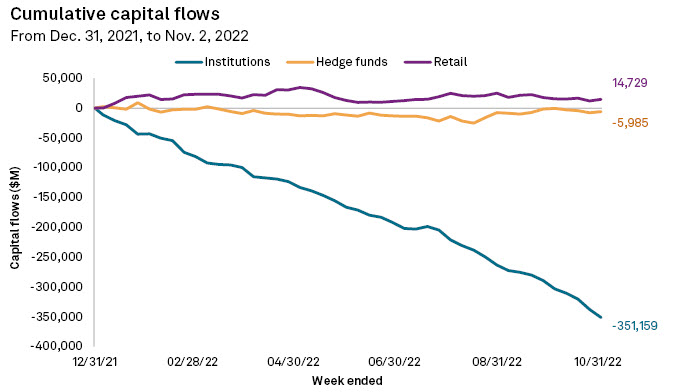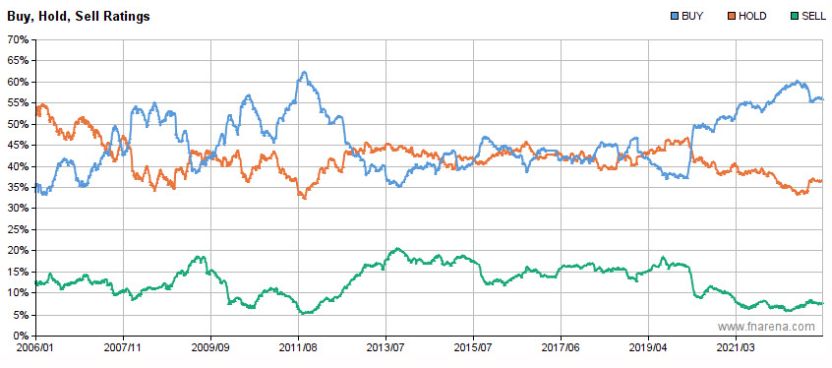Share market challenge awaits in 2023
Sometimes the most important market insight is hiding underneath daily share price movements.
Intriguingly, the latest update into who's buying and selling US equities by S&P Global Market Intelligence is showing an ever-widening gap between financial institutions (selling) and retail investors (buying).
The data available are only up to November 2, but it seems unlikely things have dramatically reversed in the two weeks since.
It is S&P Global Market Intelligence's observation that selling has been happening pretty much across the spectrum, suggesting institutions have been decreasing their exposure to equities generally, without singling out a specific sector or part of the market.
This strongly suggests risk-off attitude and a generally more defensive positioning, away from higher risk assets.
For good measure: October witnessed retail investors net selling during two weeks and net buying during two weeks for a slightly negative net outcome for the month.
But the attention-grabbing observation remains one of decisively reducing exposure by institutions, as has now been the case throughout the calendar year to date (see graphic overview below).

It is likely there is not one single reason or strategy behind these numbers, but it does add an important twist to the global debate that is dominating on social media and in the financial press these past few weeks: have we seen the bottom in global equity markets? Is the 2022 Bear Market now behind us?
It would appear institutions don't think this is the case.
****
A similar observation stems from the monthly global fund manager survey by Bank of America.
This month's outcome revealed overall sentiment remains bearish, cash levels on average are still above 6%, a recession for the US and possibly the global economy in 2023 is now pretty much the consensus view while no less than 92% of respondents is preparing for stagflation; below-trend economic growth with above-trend levels of inflation.
Around one third of respondents' major concern is that inflation might stay higher-for-longer.
Most investors see US headline inflation between 4-5% by year-end next year, too high for comfort, clearly.
With most anticipating the Federal Reserve may not pause, let alone lower the cash rate until inflation is below 4%, the prospect for higher-for-longer interest rates is clearly on everyone's mind.
At 6.2%, the average cash level sits well above the long-term average of 4.9% and only a smidgen below last month's 6.3%, which was the highest percentage on record post April of 2001.
Relative to the past 10 years, investors globally are long cash, defensives (utilities, staples, healthcare), and bonds and underweight equities, tech, eurozone equities, and cyclicals.
****
Against the background of general caution globally, Australian equities, when adjusted for dividends received, are only slightly in the negative since the start of the calendar year.
Assuming a positive trend over the final six weeks, it is not inconceivable total investment return might end up in the positive this year.
That would be truly remarkable in light of all that has happened over the past 10.5 months, also with the S&P500 and Nasdaq indices still down -15.50% and -30.5% from twelve months ago, while most commodities and bond markets have had a tough time too.
It's not difficult to see how the international debate carries a different flavour inside and outside Australia, though the challenges ahead might not be too dissimilar.
When it comes to making forecasts for the next twelve months, there won't be much disagreement among experts and forecasters about the main trends, which are:
- economic growth will be noticeably slower on the back of this year's rising interest rates and higher bond yields
- inflation should have peaked, or will have soon, and start trending down
- central banks are slowing the pace of tightening. Next step will be a pause. Next they'll start loosening again to stimulate growth
- housing markets and consumer spending will be hardest hit from this year's interest rate shock treatment
- bond yields will drop as the focus shifts to economic recessions and falling inflation, as well as the prospect of falling cash rates
- the US dollar is also peaking and will weaken in line with changing economic and market dynamics
- forecasts for corporate margins and profits are still too high; the trend in revisions needs to be negative for longer
While Australia might well see economic growth stay in the positive next year, i.e. no recession, the underlying dynamics that come with much slower growth may not be that different.
Even in the US the discussion about recession yes/no remains undecided, despite the bond market siding with the yes-sayers for many months now.
In similar fashion, some of the strategists at Morgan Stanley remain unconvinced, still, but in-house economists recently assured them: even if the recession in the US won't show up in official statistics, it certainly will feel like one on the ground and in financial markets.
If we accept the basic premise of lagged impact from tighter financial conditions on housing, consumer spending and economic growth, then the outlook for equity markets in 2023 is all about the timing of events. And as proven on multiple occasions throughout 2022, getting the timing right is very, very difficult.
In a worst case scenario, growth falls into the abyss, but inflation is not falling fast enough and thus central banks feel they cannot (yet) change course, meaning equities, and investors, are left hanging high and dry while markets get sucked in as corporate profits fall and share prices follow suit.
A much rosier scenario sees growth holding up for longer, while inflation starts descending and central banks prepare for a pause.
There will still be volatility around key trend changes, including through the bond markets, but by the time corporate profits are approaching the cycle-low, markets can already start looking forward to interest rate cuts and government stimulus.
Somewhere in between lays the actual outcome for the year ahead. But we don't know yet what scenario is most likely, and equally important, exactly when?
Given the impact for risk assets can be polar opposites, investors will want more certainty about which way forward looks most likely.
It's probably a fair assumption this uncertainty is reflected in the aforementioned data from S&P Global Market Intelligence and the global survey by Bank of America.
Equally noteworthy: most of the forward projections I've read recently by Wall Street strategists, or otherwise, only imply minor net gains for equities by the end of 2023.
This tells us nothing about the volatility that can occur in between, and many a strategist suspects we're in for an extension of 2022, at least in the first half of next year.
This is when corporate profits might show true weakness and vulnerability while inflation remains too high and central bankers persist with tightening policy.
****
In Australia, strategists at UBS just released their outlook for the calendar year ahead.
If their assumptions and projections turn out correct, the ASX200 will print 7250 by late December next year. This compares with the index closing at 7139.30 on Monday. UBS's target for end-2022 is 7000.
The key assumptions that underpin next year's outlook are more reasonable valuations on average with a soft landing for the local economy, leading corporate profits to decline throughout Q1 next year and then stabilise.
This, says UBS, should improve sentiment as forecasts can again be upgraded and corporate profits for the ASX200 are expected to grow to 4% by year-end.
That growth will not so much depend on sales and revenues, but on easing of today's margin pressures.
Costs from energy, transport and materials should be lower by then, and supply chain bottlenecks generally will be less of a constraint, while the return of immigration and a stronger AUD will be beneficial too.
Bottom line, however, is UBS's scenario for next year still implies a tough environment for the opening months.
It's not by definition different from the forecast published last week by strategists at Macquarie who stated the current up-trend in equities is not the start of a new bull market; it's simply another bear market rally, and it is nearing the end of it.
Macquarie has a slightly different timing in mind, with the cycle bottoming around mid next year but the strategists add exact timing depends on two key inputs:
- the depth of the economic recession
- whether the Federal Reserve is still constrained by high inflation
The good news is history shows equities bottom in the middle of economic recession as markets start focusing next on the recovery. In past cycles, those equities to benefit first coming out of recession include software companies, diversified financials and construction materials.
Moving into recession, however, should see defensive business models outperform, and often sharply, depending on how severe is the fall in profits caused by the recession. These businesses are relegated to market laggards as soon as the recovery announces itself.
And while nothing can be considered as set in stone at this stage, Macquarie has a sobering message for those investors hoping central banks will come to the rescue as soon as economies show signs of faltering: "it may be necessary to see a major increase in volatility, and possible a crisis to shock central banks into easing".
Macquarie is also less sanguine about average valuations on the ASX. If you incorporate earnings cuts that follow economic recessions around the world, the average PE ratio might well be as high as 21x.
Not. That. Attractive.
My own view has been that corporate profits in Australia might have a major correction downwards in February, during the local reporting season, but it's also easy to see how this timeline can shift towards August next year.
Current resilience is not by definition a comforting observation.
The trend in US profits has been deteriorating for circa two quarters and that trend is equally expected to continue.
On Morgan Stanley's freshly updated forecasts, global GDP growth is slowing to 2.2% next year, from a projected 3% this year, and down from 6.2% in 2021.
****
Earnings forecasts in Australia already are for tepid growth in FY23, FY24 and FY25 and the general trend remains to the downside.
Still enjoying upgrades are cyclical companies that report out-of-normal-season, including United Malt Group (UMG) and Nufarm (NUF), plus Aristocrat Leisure (ALL), as well as the likes of Netwealth Group (NWL) and National Storage REIT (NSR).
Many more companies are experiencing cuts to forecasts by analysts, including out-of-season cyclicals such as GrainCorp (GNC), Incitec Pivot (IPL) and Elders (ELD) while analysts have been lowering forecasts for companies including Flight Centre (FLT), Ramsay Health Care (RHC), Pact Group (PGH) and Nine Entertainment (NEC).
The average Price-Earnings ratio for the ASX200 is around 13.5x, which looks "cheap" on historical comparisons, but further cuts to forecasts would push up that number. As stated earlier, Macquarie suggests if next year proves bad for profits, the real PE in Australia could be as high as 21x.
Hiding behind the broad number are average valuations for banks and financials, still relatively high valuations for quality industrials and seemingly low PEs for resources stocks.
Dividend yields are above historical averages because of the de-rating of bond proxies and retailers, combined with exceptional liquidity for segments of the resources sector.
On FNArena's data, total ratings by the seven stockbrokers monitored daily consist of nearly 56% Buy and equivalent ratings and only 36.5% Neutral/Holds and 7.5% Sells.
Historically, such strong overweight towards Buy ratings has always corresponded with a bear market as the direct correlation between valuations and share prices is brutally disrupted.

This correlation will have to be normalised, probably through a combination of reductions in forecasts (which also lower valuations and thus ratings) and falling and rising share prices.
Unfortunately, this proprietary indicator provides no timing of when exactly this might happen (or how precisely).
FNArena offers ahead-of-the-curve, impartial and independent market insights and analysis, on top of proprietary tools and applications for self-researching and self-managing investors. The service can be trialed here.
5 topics
5 stocks mentioned

